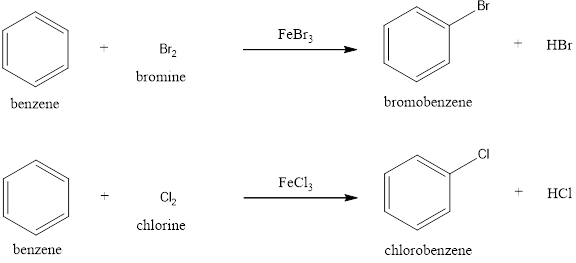
Concept explainers
(a)
Interpretation:
The missing reactant in the given conversion has to be identified.
Concept Introduction:
Alkylation:
Benzene undergoes alkylation reaction in presence of AlCl3 as catalyst. The alkyl group from alkyl chloride gets substituted for a hydrogen atom in the benzene ring. The product obtained is alkylbenzene. The general reaction scheme can be given as,

Halogenation:
Benzene undergoes halogenation reaction in presence of FeCl3 or FeBr3 as catalyst to give halobenzene as product. The general reaction scheme can be given as,

(c)
Interpretation:
The missing reactant in the given conversion has to be identified.
Concept Introduction:
Aromatic hydrocarbons undergo substitution reactions rather than addition reactions. Even though the aromatic hydrocarbon has double bonds in its structure, they undergo substitution reaction only because the double bonds are involved in delocalized bonding that is present in the ring system.
Alkylation:
Benzene undergoes alkylation reaction in presence of AlCl3 as catalyst. The alkyl group from alkyl chloride gets substituted for a hydrogen atom in the benzene ring. The product obtained is alkylbenzene. The general reaction scheme can be given as,

Halogenation:
Benzene undergoes halogenation reaction in presence of FeCl3 or FeBr3 as catalyst to give halobenzene as product. The general reaction scheme can be given as,

(c)
Interpretation:
The missing product in the given conversion has to be identified.
Concept Introduction:
Aromatic hydrocarbons undergo substitution reactions rather than addition reactions. Even though the aromatic hydrocarbon has double bonds in its structure, they undergo substitution reaction only because the double bonds are involved in delocalized bonding that is present in the ring system.
Alkylation:
Benzene undergoes alkylation reaction in presence of AlCl3 as catalyst. The alkyl group from alkyl chloride gets substituted for a hydrogen atom in the benzene ring. The product obtained is alkylbenzene. The general reaction scheme can be given as,

Halogenation:
Benzene undergoes halogenation reaction in presence of FeCl3 or FeBr3 as catalyst to give halobenzene as product. The general reaction scheme can be given as,

Trending nowThis is a popular solution!

Chapter 13 Solutions
General, Organic, and Biological Chemistry
- Suppose the rate of evaporation in a hot, dry region is 1.76 meters per year, and the seawater there has a salinity of 35 ‰. Assuming a 93% yield, how much salt (NaCl) can be harvested each year from 1 km2 of solar evaporation ponds that use this seawater as a source?arrow_forwardhelparrow_forwardExplain why only the lone pairs on the central atom are taken into consideration when predicting molecular shapearrow_forward
- (ME EX1) Prblm #9/10 Can you explain in detail (step by step) I'm so confused with these problems. For turmber 13 can u turn them into lewis dot structures so I can better understand because, and then as well explain the resonance structure part. Thanks for the help.arrow_forwardProblems 19 and 20: (ME EX1) Can you please explain the following in detail? I'm having trouble understanding them. Both problems are difficult for me to explain in detail, so please include the drawings and answers.arrow_forward(ME EX1) Prblm #4-11 Can you please help me and explain these I'm very confused in detail please. Prblm number 9 I don't understand at all (its soo confusing to me and redraw it so I can better depict it).arrow_forward
- ME EX1) Prblm #19-20 I'm so confused with these problems. Can you please help me solve them and explain them? Problems number 19-20, and thanks! step by step and in detail for me please helparrow_forwardCalculate the flux of oxygen between the ocean and the atmosphere, given that: Temp = 18°C Salinity = 35 ppt Density = 1025 kg/m3 Oxygen concentration measured in bulk water = 263.84 mmol/m3 Wind speed = 7.4 m/s Oxygen is observed to be about 10% initially supersaturatedarrow_forward( ME EX1) Prblm 27-28: Can you explain to me both prblms in detail and for prblm 28 what do you mean bi conjugated bi ponds and those structures I'm confused...arrow_forward
- A. Determine the number of electrons in a system of cyclic conjugation (zero if no cyclic conjugation). B. Specify whether the species is "a"-aromatic, "aa"-anti-aromatic, or "na"-non-aromatic (neither aromatic nor anti-aromatic). (Presume rings to be planar unless structure obviously prevents planarity. If there is more than one conjugated ring, count electrons in the largest.) 1. A.Electrons in a cyclic conjugated system. 18 B.The compound is (a, aa, or na) a 2. A.Electrons in a cyclic conjugated system. 10 B.The compound is (a, aa, or na) naarrow_forwardWater is boiling at 1 atm pressure in a stainless steel pan on an electric range. It is observed that 2 kg of liquid water evaporates in 30 min. Find the rate of heat transfer to the water (kW).arrow_forwardCould you please turn this into a complete Lewis dot structure formula for me so I can visualize it more clearly? and then do the explaining for the resonance structures that were given please.arrow_forward
 Organic And Biological ChemistryChemistryISBN:9781305081079Author:STOKER, H. Stephen (howard Stephen)Publisher:Cengage Learning,
Organic And Biological ChemistryChemistryISBN:9781305081079Author:STOKER, H. Stephen (howard Stephen)Publisher:Cengage Learning, General, Organic, and Biological ChemistryChemistryISBN:9781285853918Author:H. Stephen StokerPublisher:Cengage Learning
General, Organic, and Biological ChemistryChemistryISBN:9781285853918Author:H. Stephen StokerPublisher:Cengage Learning Chemistry: The Molecular ScienceChemistryISBN:9781285199047Author:John W. Moore, Conrad L. StanitskiPublisher:Cengage Learning
Chemistry: The Molecular ScienceChemistryISBN:9781285199047Author:John W. Moore, Conrad L. StanitskiPublisher:Cengage Learning Chemistry: Principles and PracticeChemistryISBN:9780534420123Author:Daniel L. Reger, Scott R. Goode, David W. Ball, Edward MercerPublisher:Cengage LearningChemistry: Matter and ChangeChemistryISBN:9780078746376Author:Dinah Zike, Laurel Dingrando, Nicholas Hainen, Cheryl WistromPublisher:Glencoe/McGraw-Hill School Pub Co
Chemistry: Principles and PracticeChemistryISBN:9780534420123Author:Daniel L. Reger, Scott R. Goode, David W. Ball, Edward MercerPublisher:Cengage LearningChemistry: Matter and ChangeChemistryISBN:9780078746376Author:Dinah Zike, Laurel Dingrando, Nicholas Hainen, Cheryl WistromPublisher:Glencoe/McGraw-Hill School Pub Co





